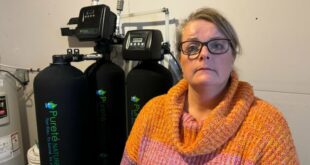Former search and rescue vessel brought from Vancouver to Caraquet

The Canadian Coast Guard is calling and they want you to buy a hovercraft.
Not a familiar scenario?
It is for Gino LeBlanc, of Caraquet. He was not surprised when the call came in last fall.
"In the world of big hovercraft, it's a small world," He jokes.
But if they thought they had found the perfect buyer, LeBlanc at first said no. For one thing, he already had one.
Eventually, after a visit to the coast guard's hovercraft base on Sea Island in Richmond, B.C., to see the retired search and rescue vessel, he changed his mind.
Only one problem remained.
"Unfortunately, the hovercraft was not on the right ocean," LeBlanc said.

From Copenhagen to Caraquet: Making waves with Gino’s hovercraft
Gino LeBlanc wants you to see his hovercraft, The Penac, which had quite the journey getting to New Brunswick.
In the months that followed, LeBlanc and his crew would prepare for — and embark on— a "once in a lifetime" journey to bring the hovercraft all the way to his hometown in northeastern New Brunswick, where he co-owns Northeast Diving Ltd.
B.C. to New Brunswick, via Panama
Most Canadians would love to knock a cross-country road trip off their bucket list. But when you are the proud new owner of a hovercraft, it's not so simple.
Too big to transport by road, it would have to sail.
LeBlanc spent the winter in B.C. at the coast guard base, learning the ins and outs of this particular craft.
"We received tremendous knowledge over there that you can't buy. It would take years to learn it by yourself," LeBlanc said.
Known as the Penac, the hovercraft has an international history. Built in 1984 by a British company, it was first used for passenger transport in Copenhagen.
Fast forward to 2004 and it was acquired by the Canadian Coast Guard, used for search and rescue until it was decommissioned in 2017.
Six years would pass until the Penac's next big adventure.
After his training was complete, LeBlanc said he had the craft loaded onto a cargo ship to leave B.C for Baltimore, Md., by way of the Panama Canal and around Florida.
Although he didn't want to say how much he paid for the Penac, he did say it cost $500,000 to ship it to Baltimore.
When it reached Baltimore, the real adventure began.
LeBlanc and three crew members sailed the craft north, accompanied by a Canadian Coast Guard captain who had piloted the vessel for years before its sale.
The old adage rings true, even for a trip by hovercraft: it's the journey, not the destination.
"We didn't have an ETA to arrive in Caraquet, so we took some time," LeBlanc said.
The hovercraft needed to fuel every day and stop on a beach come nightfall, giving LeBlanc and his crew plenty of excuses to stop along the way.
"All the locals were amazing, everybody was providing us food, and a lot of people went through the craft. We were a tour guide for two weeks on the ocean."
From the captain's chair, LeBlanc got to see the whole eastern seaboard on what he calls a "trip of a lifetime."
"The highlight was going through New York, and Rhode Island was amazing scenery, beaches, beaches — Cape Cod, Boston," he said.
And while the Penac drew eyes in the States, it's not such a strange sight in his neighbourhood..
"Here in the Acadian Peninsula and Gaspé, we are used to hovercrafts," LeBlanc said, explaining that the coast guard regularly uses them for ice breaking in the region.
A new home in New Brunswick
The trip might be over, but LeBlanc's involvement with the vessel is just beginning.
With a marine background overseeing his diving and wharf-building companies, LeBlanc is quick to list off the possibilities.
Aside from tourism purposes, it can be used for search and rescue operations, cargo transport and scientific research.
"It's all rigged up for it," he said.
He's only been back for a few days, but already companies are reaching out to express interest.
As for this adventure, would he do it all again?
"Not right now. I've been two weeks and a half on it," LeBlanc said with a chuckle.
But once he settles back into his seaside life in Caraquet, he is excited about what comes next.
"I'm open to go anywhere with it," LeBlanc said.
*****
Credit belongs to : www.cbc.ca
 MaharlikaNews | Canada Leading Online Filipino Newspaper Portal The No. 1 most engaged information website for Filipino – Canadian in Canada. MaharlikaNews.com received almost a quarter a million visitors in 2020.
MaharlikaNews | Canada Leading Online Filipino Newspaper Portal The No. 1 most engaged information website for Filipino – Canadian in Canada. MaharlikaNews.com received almost a quarter a million visitors in 2020.







